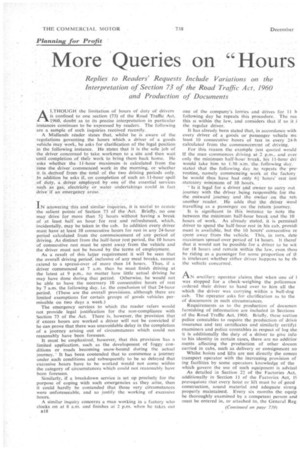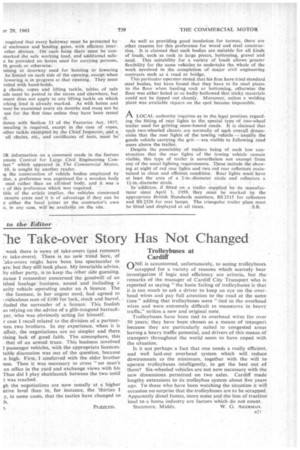More Queries on "Hours
Page 52

Page 55

If you've noticed an error in this article please click here to report it so we can fix it.
Replies to Readers' Requests Include Variations on the Interpretation of Section 73 of the Road Traffic Act, 1960 and Production of Documents
ALTHOUGH: the limitationof hours of duty of drivers is confined to one 'section (73) of the Road Traffic Act. 1966, doubt. as to its precise interpretation in particular instances continues to' be expressed by readers. The following are a sample of such inquiries received recently.
• A Midlands reader states that, whilst he is aware of the regulations ,governing the hours which, a driver of a goods vehicle may work, he asks for clarification of the legal position
• in the following instance. He. states that it is the sole job of the driver concerned to take, workmen to a site and then wait 'until completion of their work to bring them back home. He asks whether the II_I-hour Maximum is calculated from the Anne the driver 'commenced work in the morning, or-whether it is derivedfrom the total 'of the two driving periods only. In addition he asks if, on completion of such an 11-hour spell of duty, a driver employed. by one of the essential services such as gas; electricity or , water -undertakings could in fact .drive if an emergency arose.. . • IN answering this and similar inquiries, it is Useful to restate the salient points of Section 73 of the Act. Briefly, no one 'may drive for more than SI -hours without having a break of at least half. an hour for rest and refreshment, which, incidentally, may betaken in the cab. In addition every driver must have at least 10 consecutive hours for rest in any 24-hour
• period calculated from the commencement of any period of driving. As distinct from the half-hour rest period, the 10 hours of consecutive rest must be spent away from the vehicle and the driver must not be bound by the terms of employment.
As a result of this latter requirement it will be seen that the overall driving period, inclusive of any meal breaks, cannot extend to a spread-over of more than 14 hours. Thus, if a driver commenced at 7 am. then he must finish driving at the latest at 9 p.m., no matter how little actual driving he may have done during that period. Otherwise, he would not be able to have the necessary 10 consecutive hours of rest by 7 a.m. the following day, i.e. the conclusion of that 24-hour period, (These are the overall provisions, although there are limited exemptions for certain groups of goods vehicles permissible on two dap.; a week.)
The emergency services to which the reader refers would not provide legal justification for the non-compliance with Section 73 of the Act. There is, however, the provision that if excess hours are worked a driver will not be convicted if he can prove that there was unavoidable delay in the completion of a journey arising out of circumstances which could not reasonably have been foreseen. It must be emphasized, however, that this provision has a limited application, such as the development of foggy conditions or roads becoming snow-bound during the actual journey. It has been contended that to commence a journey under such conditions and subsequently to be so delayed that excessive hours have to be worked would not come within the category of circumstances which could not reasonably have been foreseen.
Similarly, if a breakdown service is set up precisely for the purpose of coping with such emergencies as they arise, then it could hardly be contended that those very circumstances were unforeseeable. and so justify the working of excessive hours.
A similar inquiry concerns a man working in a factory who clocks on at 8 a.m, and finishes at 2 p.m. when he takes out B18 one of the company's lorries and drives for 11 h following day he repeats this procedure. The rea this is within the law, and considers that if so it i the regular driver.
It has already been stated that, in accordance with every driver of a goods orpassenger vehicle' mi. least .10 consecutive hours of rest in every 24-h calculated from the commencement of driving.
For thia reason the example 'just quoted would if the man commences ,driving at 2 p.m., and ever only the minimum •half-hour break, his 11-hour would take him to 1:30.:a.m:the..following day. stated that the following, day he repeats the "pre' routine, namely commencing. work at the factory he would thus have had Only 61hours' rest .inst _statutory minimum of 10 hours.
"Is it legal for a driver and owner to carry out journey with the driver _being resppnsible for the the outward journey and _the Owner OR the teti another reader. He adds that the driver woul travelling as a passenger . on the return -journey.
It is significant in this instance to note the between the Minimum hail-hour break and the 10 • hours of work. As already stated, it is permissil driver to spend the half-hour rest in his cab, providi ment is available, but the 10 hours' consecutive re spent away from the vehicle. This, in turn, dete maximum spread-over period of 14 hours. It theref that it would not be possible for a driver to be wit for IS hours and remain ,within the law, even thou he riding as a passenger for some proportion of It is irrelevant whether either driver happens to be tb. the vehicle concerned.
AN ancillary operator claims that when one of 1 was stopped for a check-weighing the policeman ordered their driver to hand over to him all the which the driver was carrying within a bull-dog cab. The operator asks for clarification as to the of documents in such circumstances.
Requirements as to the production of clocumen furnishing of information are included in Sections of the Road Traffic Act, 1960. Briefly, these section police constables to require the production of drivit insurance and test certificates and similarly certifyi examiners and police constables in respect of log she it is additionally the duty of a driver to give info to his identity in certain cases, there are no additior ments affecting the production of other docurn carried in cabs, such as delivery or consignment no Whilst hoists and lifts are not directly the comer transport operator with the increasing provision of ing facilities by some operators knowledge of the which govern the use of such equipment is acIvisal As detailed in Section 22 of the Factories Act, additionally in Section 11 of the Factories Act, 1..t: prerequisite that every hoist or lift must be of good construction, sound material and adequate streng properly maintained. Every six months the equip be thoroughly examined by a competent person and must be entered in, or attached to, the General Reg
required that every hoistway must be protected by al enclosure and landing gates, with efficient interother devices. On each hoist there must be 'conmarked the safe working load, and additional safea be provided on hoists used for carrying persons, th goods or otherwise.
'ening or doorway used for hoisting or lowering he fenced on each side of the opening, except when lowering is in progress at that opening. They must vided with hand-holds.
g chains, ropes and lifting tackle, tables of safe ads must be posted in the stores and elsewhere, but rnent does not apply to any lifting tackle on which Drking load is already marked. As with hoists and nust -be examined every six months and must not be use for the first time unless they have been tested d.
dance with Section 23 of the Factories Act, 1937, mealing is required, except in the case of ropes, other tackle exemPted by the Chief Inspector, and .a all chains, etc., and certificates of tests, must be E.R information on a .comment made in the feature emote Control for Large Civil Engineering Conleet " which appeared in The Commercial Motor, 10, is sought by another reader,
ig the construction of vehicle bodies employed by ;tor, a preference was expressed for a wooden body steel rather than an alUsteel body, and it was a of this preference which was required.
title of the article implies, the vehicles concerned remote areas and it is of advantage if they can be y either the local joiner or the contractor's own o, in any case, will be available on the site. As well as providing good insulation for tarmac, there are other reasons for this preference for wood and steel construction. It is _claimed that such bodies are suitable for all kinds of loads, such as rock in large pieces, bottoming, gravel and sand. This suitability for a variety of loads allows greater flexibility for the same vehicles to undertake the whole of the work involved in the completion of major civil engineering contracts such as a road or bridge.
This particular operator stated that his firm have tried standard steel bodies, but have found that they have to fix steel plates to the floor when hauling rock or bottoming, otherwise the floor was either holed or so badly hollowed that sticky materials could not be tipped out cleanly. Moreover, unless a welding plant was available repairs on the spot became impossible, ALOCAL authority inquires as to the legal position regarding the fitting of rear lights to the special type of two-wheel trailer used for gritting snow-bound roads. It is claimed that such two-wheeled chassis are normally of such overall dimensions that the rear lights of the towing vehicle —usually the goods vehicle carrying the grit — are visible to following road users above the trailer.
Despite the possibility of trailers being of such low construction that the rear lights of the towing vehicle remain visible, this type of trailer is nevertheless not exempt from any of the usual lighting requirements. These include the showing at night of red rear lights and two red rear reflectors maintained in clean and efficient condition. Rear lights must have at least the area of a 2-in.-diameter circle and reflectors a 11-in.-diameter circle.
In addition, if fitted on a trailer supplied by its manufacturer since April 1, 1959,• they must be marked by the appropriate British Standards numbers, BS 2515 for reflectors and BS 2526 for rear lamps. The triangular trailer plate must be fitted and displayed at all times. S.B.




























































































